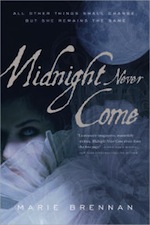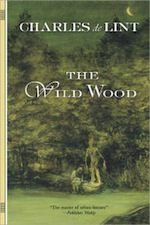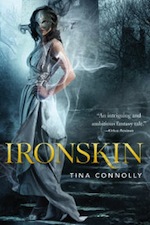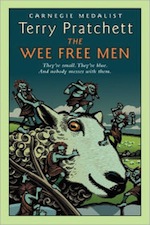I love fairy tales and fairy stories but being something of a traditionalist, I prefer pixies (or pictsies) who know their own mind, rather than those that seem to exist simply to add dew drops to spider webs and grant wishes when caught. When I wrote Domnall and the Borrowed Child, I went back to the Scottish myths. The fae were to be placated, not courted, and no one in their right mind would call them by name. Within the story, the humans are just not all that important to the Seelie court near Aberdeen, except when the Fair Folk want something of us.
To back up my viewpoint, I’ve collected five modern books, where modern is defined as post-Disney. All of them are books I love but, not coincidentally, they also include fairies that would rather steal your soul than sprinkle you with fairy dust.
Midnight Never Come by Marie Brennan
 Marie Brennan is best known for A Natural History of Dragons but I first discovered her when a good friend read my drafts and told me I needed to read Brennan’s faerie world. I have good friends! The faeries in the Onyx Court series aren’t bit characters in a larger plot: they are the story, living their lives while being fully three-dimensional and bad-ass without even trying. No sparkles here! Funnily enough, it was Brennan who made me aware that it was possible to descend into the London sewers as a guest of Thames water, an amazing experience that formed the core of my novel-in-progress (not faeries).
Marie Brennan is best known for A Natural History of Dragons but I first discovered her when a good friend read my drafts and told me I needed to read Brennan’s faerie world. I have good friends! The faeries in the Onyx Court series aren’t bit characters in a larger plot: they are the story, living their lives while being fully three-dimensional and bad-ass without even trying. No sparkles here! Funnily enough, it was Brennan who made me aware that it was possible to descend into the London sewers as a guest of Thames water, an amazing experience that formed the core of my novel-in-progress (not faeries).
The Onyx Court series takes place beneath London: a subterranean faerie realm full of politics and drama. The series is historical, running from 1499 to 1884. The first novel, Midnight Never Come, connects the dark Faerie court’s Machiavellian scheming to the reign of Queen Elisabeth the Virgin Queen. If you are interested in terrifying and captivating faeries with their own fully thought-out world, then I heavily recommended you start here.
The Wild Wood by Charles de Lint
 The Wild Wood tells the story of Eithnie, a young artist who has retreated to her family’s cabin in the wood to work on her illustrations. One of the charming things about de Lint’s portrayal of the fae in the story is that they never take centre stage. The strange and ugly stickmen are on the periphery of the novel, pushing at the boundaries, just as his fairy world interacts with the real one. The world of Faerie is asking Eithnie to help but they won’t or can’t explain to her how. The faerie world of de Lint isn’t comprehensible to us, doesn’t rely on us, and doesn’t actually care about us. As a result, their attempts at communication are confusing and poor Eithnie starts to wonder if she might be losing her mind.
The Wild Wood tells the story of Eithnie, a young artist who has retreated to her family’s cabin in the wood to work on her illustrations. One of the charming things about de Lint’s portrayal of the fae in the story is that they never take centre stage. The strange and ugly stickmen are on the periphery of the novel, pushing at the boundaries, just as his fairy world interacts with the real one. The world of Faerie is asking Eithnie to help but they won’t or can’t explain to her how. The faerie world of de Lint isn’t comprehensible to us, doesn’t rely on us, and doesn’t actually care about us. As a result, their attempts at communication are confusing and poor Eithnie starts to wonder if she might be losing her mind.
The silvery threads of the faerie sparkle in the shadows as Eithnie tries to work out how to save the grove. In the end, the answer is in her dreams and never really reconcilable with the modern world. This is possibly not the most comforting of fairy tales but feels more real than many more specific portrayals.
Tithe by Holly Black
 Tithe was Holly Black’s first novel and the first of her modern faerie tale series. The story follows sixteen-year-old Kaye’s descent into the faerie world that lives alongside ours. The protaganist is a strong character who happens to things, as opposed to things happening to her. Teenagers may not come out of this looking very good but Black does an amazing job of showing the darker side of faerie.
Tithe was Holly Black’s first novel and the first of her modern faerie tale series. The story follows sixteen-year-old Kaye’s descent into the faerie world that lives alongside ours. The protaganist is a strong character who happens to things, as opposed to things happening to her. Teenagers may not come out of this looking very good but Black does an amazing job of showing the darker side of faerie.
The Unseelie Court is, of course, visibly depraved but the Seelie court has its own politics and dark secrets. The solitary fae have always been a part of Kaye’s life, her childhood “invisible” friends, but they are also savage and selfish. Lutie-Loo may look like Tinkerbell but she spends her time tangling knots into the hair of everyone she loves. Black’s faeries are cruel, self-centred and just on the edge of sane—just the way they should be.
Ironskin by Tina Connolly
 Described as “Steampunk Jane Eyre,” Ironskin tells the story of Jane Eliot, a young woman wounded in the Great Battle with the Fey. We never see the fey in Ironskin, which makes them all the more disturbing. Instead, we see the damage they left behind. Jane Eliot has to wear an iron mask to control the rage bubbling under the surface of her face where she was struck by shrapnel.
Described as “Steampunk Jane Eyre,” Ironskin tells the story of Jane Eliot, a young woman wounded in the Great Battle with the Fey. We never see the fey in Ironskin, which makes them all the more disturbing. Instead, we see the damage they left behind. Jane Eliot has to wear an iron mask to control the rage bubbling under the surface of her face where she was struck by shrapnel.
The result is a dark and brooding feeling of danger as we see the direct effects of the Great War on the general populace and the resulting fear and protections required to keep safe from the deadly Fey. The novel leaves you wanting more – which is good, as the series continues with Copperhead and Silverblind.
The Wee Free Men by Terry Pratchett
 It would be impossible to discuss modern faeries without a nod to Sir Pratchett. In The Wee Free Men, Tiffany Aching is forced into Fairyland to rescue her little brother with little more to defend herself with than an iron frying pan. This is no place of fairy dances and fine feasts but an ever-shifting landscape of confusion and terror, guarded by wolves and dromes. The Queen of the Elves is a cruel mistress of the shadow world and will stop at nothing to trap Tiffany within her own nightmares. But Tiffany also has fairy allies: the Nac Mac Feegle. The picties are the most feared of all the fairy races, “even the trolls run away from the Wee Free Men,” Miss Tick tells Tiffany.
It would be impossible to discuss modern faeries without a nod to Sir Pratchett. In The Wee Free Men, Tiffany Aching is forced into Fairyland to rescue her little brother with little more to defend herself with than an iron frying pan. This is no place of fairy dances and fine feasts but an ever-shifting landscape of confusion and terror, guarded by wolves and dromes. The Queen of the Elves is a cruel mistress of the shadow world and will stop at nothing to trap Tiffany within her own nightmares. But Tiffany also has fairy allies: the Nac Mac Feegle. The picties are the most feared of all the fairy races, “even the trolls run away from the Wee Free Men,” Miss Tick tells Tiffany.
Pratchett’s faeries of all stripes are perfectly frightful and utterly bad-ass.
Top image from the Norwegian edition of The Wee Free Men.
Sylvia Spruck Wrigley is an American/German writer of science fiction, fantasy and aviation non-fiction. Her upcoming novella, Domnall and the Borrowed Child, publishes November 10th from Tor.com. Read an excerpt from this fairy-story here.









